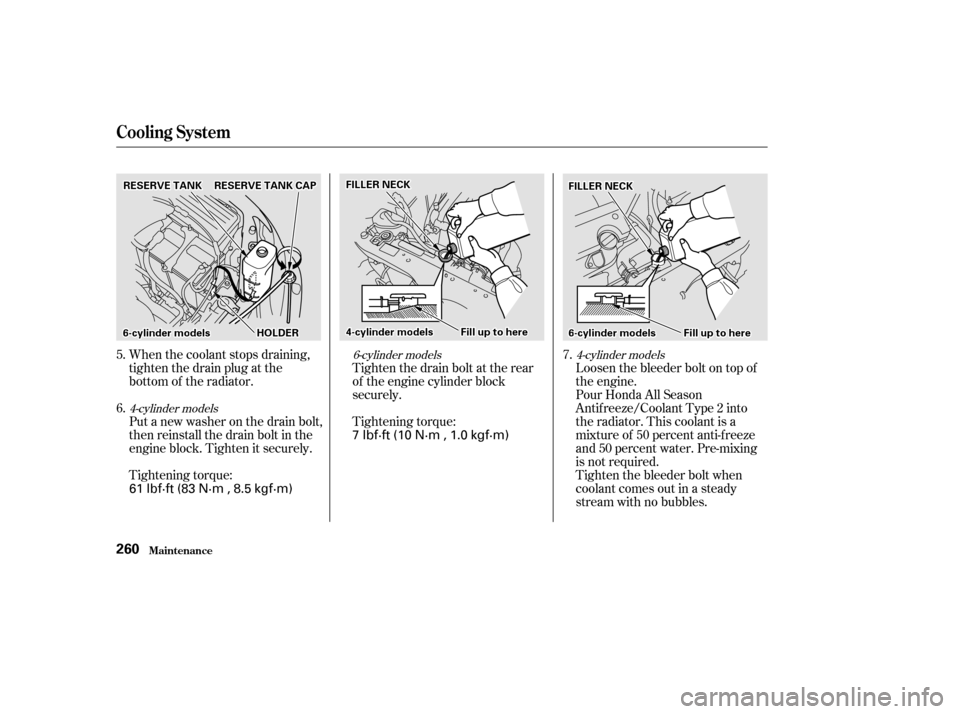Page 26 of 158
For security, this cover can be
locked and unlocked only with the
master key. To lock the cover, insert
thekeyandturnitclockwise.
The pass-through cover can be
opened f rom either side; it f olds
f orward onto the center armrest.
Open the cover by sliding the knob
downward and pushing or pulling on
the cover. To close the cover, swing
it up and push f irmly on the top.
Make sure it latches properly.
Make sure all items in the trunk and
those extending through the pass-
through are secured. Never drive with this cover open and
the trunk lid open.
See on
page .
51
Seat A djustments
Inst rument s and Cont rols
T runk Pass-through Cover
Carbon Monoxide Hazard
89
KKNNOOBB
LLIIDD
Page 65 of 158

Canadian Owners:
The remote control you are training
from may stop transmitting after two
seconds. This is not long enough f or
HomeLink to learn the code. Release
and press the button on the remote
control every two seconds until
HomeLink has learned the code.For security purposes, newer garage
door opening systems use a ‘‘rolling’’
or variable code. Inf ormation f rom
the remote control and the garage
door opener are needed bef ore
HomeLink can operate the garage
door opener.
The‘‘Training HomeLink’’ procedure
trains HomeLink to the proper
garage door opener code. The
f ollowing procedure synchronizes
HomeLink to the garage door opener
so they send and receive the correct
codes.
The red light in HomeLink should
begin f lashing. It will f lash slowly
at first, then rapidly.
When the red light f lashes rapidly,
release both buttons. HomeLink
should have learned the code from
the remote control.
Plug in the garage door opener
motor, then test the HomeLink
transceiver button by pushing it. It
should operate the garage door.
If the button does not work, repeat
this procedure to train it again. If it
still does not work, you may have a variable or rolling code garage
door opener. Test this by pressing
and holding the HomeLink
transceiver button you just trained.
If the red light blinks f or two
seconds,thenstayson,youhavea
rolling code garage door opener.
You may be able to verify this with
the manufacturer’s documentation.
Go to ‘‘Training With a Rolling
Code System.’’
Repeat these steps to train the
other two HomeLink buttons to
operate any other remotely-
controlled devices around your
home (lighting, automatic gate,
security system, etc.).
5. 6.
8.
7. T raining With a Rolling Code
System
HomeL ink Universal T ransceiver
Comf ort and Convenience Feat ures190
Page 69 of 158
CONT INUED
To close the hood, lif t it up slightly to
remove the support rod f rom the
hole. Put the support rod back into
its holding clip. Lower the hood to
about a f oot (30 cm) above the
fender,thenletitdrop.
After closing the hood, make sure it
is securely latched.Lif t the hood up most of the way.
The hydraulic supports will lif t it
uptherestof thewayandholditup.
Pull the support rod out of its clip
and insert the end into the hole on
the f ront of the hood around the
center. 3.
3.
6-cylinder models
4-cylinder models
Bef ore Driving
Service Station Procedures
197
SSUUPPPPOORRTTRROODD
Page 72 of 158

Store or secure all items that could
be thrown around and hurt
someone during a crash.
Be sure items placed on the f loor
behind the f ront seats cannot roll
under the seats and interf ere with
the driver’s ability to operate the
pedals, or with the proper
operation of the seats.
Keep the glove box closed while
driving. If the lid is open, a
passenger could injure their knees
during a crash or sudden stop.
This f igure includes the total weight
of all occupants, cargo, accessories,
and the tongue weight if you are
towing a trailer.
The f inal number is the total weight
of cargo you can carry.
If you are towing a trailer, add the
tongue weight to the number
above.
Add up the weight of all occupants.
To f igure out how much cargo you
can carry:
The maximum load for your car is
850 lbs (395 kg).
Do not put any items on top of the
rear shelf . They can block your
view and be thrown around the car
during a crash.
Subtract the total f rom 850 lbs
(395 kg). Carrying Items in the Passenger
Compartment
Load Limit
Carrying Cargo
Bef ore Driving205
Overloading or improper
loading can affect handling and
stability and cause a crash in
which you can be hurt or killed.
Follow all load limits and other
loading guidelines in thismanual.
Page 80 of 158

Always use saf ety chains. Make sure
they are secured to both the trailer
and hitch, and that they cross under
the tongue so they can catch the
trailer if it becomes unhitched.
Leave enough slack to allow the
trailer to turn corners easily, but do
not let the chains drag on the ground.
Honda recommends that any trailer
having a total weight of 1,000 lbs
(450 kg) or more be equipped with
its own electric or surge-type brakes.
If you choose electric brakes, be
sure they are electronically actuated.
Do not attempt to tap into your
vehicle’s hydraulic system. No
matter how successf ul it may seem,
any attempt to attach trailer brakes
to your vehicle’s hydraulic system
will lower braking ef f ectiveness and
create a potential hazard.
Any hitch used on your vehicle must
be properly bolted to the underbody.
Discuss your needs with your trailer
sales or rental agency, and f ollow the
guidelines in the rest of this section.
Also make sure that all equipment is
properly installed and that it meets
f ederal, state, province, and local
regulations.
Towing can require a variety of
equipment, depending on the size of
your trailer, how it will be used, and
how much load you are towing.
The best way to conf irm that vehicle
and trailer weights are within limits
is to have them checked at a public
scale.
Using a suitable scale or a special
tongue load gauge, check the tongue
load the f irst time you set up a
towing combination (a f ully-loaded
vehicle and trailer), then recheck the
tongue load whenever the conditions
change.
Towing a Trailer
Driving
Saf et y Chains
Trailer Brakes
HitchesT owing Equipment and
A ccessories
Checking L oads
229
Page 82 of 158

Many states and Canadian provinces
require special outside mirrors when
towing a trailer. Even if they don’t,
you should install special mirrors if
you cannot clearly see behind you, or
if the trailer creates a blind spot.
Askyourtrailersalesorrental
agency if any other items are
recommended or required f or your
towing situation.When preparing to tow, and bef ore
driving away, be sure to check the
f ollowing:
Your vehicle tires and spare are
properly inf lated (see page ),
and the trailer tires and spare are
inflated as recommended by the
trailer maker.
The vehicle has been properly
serviced, and the tires, brakes,
suspension, and cooling system
are in good operating condition.
All weights and loads are within
limits (see pages and ).
Thehitch,safetychains,andany
other attachments are secure.
Allitemsonandinthetrailerare
properly secured and cannot shif t
while you drive.
The lights and brakes on your
vehicle and the trailer are working
properly. 227 228
285
Additional Trailer EquipmentPre-T ow Checklist
Towing a Trailer
Driving231
Page 99 of 158

When the coolant stops draining,
tightenthedrainplugatthe
bottom of the radiator.
Put a new washer on the drain bolt,
then reinstall the drain bolt in the
engine block. Tighten it securely.
Tightening torque:Tighten the drain bolt at the rear
of the engine cylinder block
securely.
Tightening torque:
Loosen the bleeder bolt on top of
the engine.
Pour Honda All Season
Antif reeze/Coolant Type 2 into
the radiator. This coolant is a
mixture of 50 percent anti-f reeze
and 50 percent water. Pre-mixing
is not required.
Tighten the bleeder bolt when
coolant comes out in a steady
stream with no bubbles.
7.
6.
5.
4-cylinder models 6-cylinder models 4-cylinder models
Cooling Syst em
Maint enance260
FFIILLLLEERRNNEECCKK
44--ccyylliinnddeerrmmooddeellssFFiilllluuppttoohheerree
FFIILLLLEERRNNEECCKK
66--ccyylliinnddeerrmmooddeellssFFiilllluuppttoohheerree
RREESSEERRVVEETTAANNKKCCAAPPRREESSEERRVVEETTAANNKK
66--ccyylliinnddeerrmmooddeellssHHOOLLDDEERR
61 lbf·ft (83 N·m , 8.5 kgf·m)
7 lbf·ft (10 N·m , 1.0 kgf·m)
Page 101 of 158
Insert the dipstick all the way into
the transmission securely as
shown in the illustration.
Remove the dipstick and check
the f luid level. It should be
between the upper and lower
marks.
Check the f luid level with the engine
at normal operating temperature.
Park the car on level ground. Shut
of f the engine.
Remove the dipstick (yellow loop)
f rom the transmission and wipe it
with a clean cloth.
Insert the dipstick all the way back
into the transmission securely as
shown in the illustration.
The transmission should be drained
and ref illed with new f luid according
to the time and distance recommen-
dations in the maintenance schedule.
1. 2.3. 4.
6.
6-cylinder models
T ransmission Fluid
Maint enance
Automatic Transmission
264
UUPPPPEERRMMAARRKK
DDIIPPSSTTIICCKKLLOOWWEERRMMAARRKK